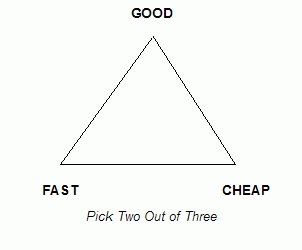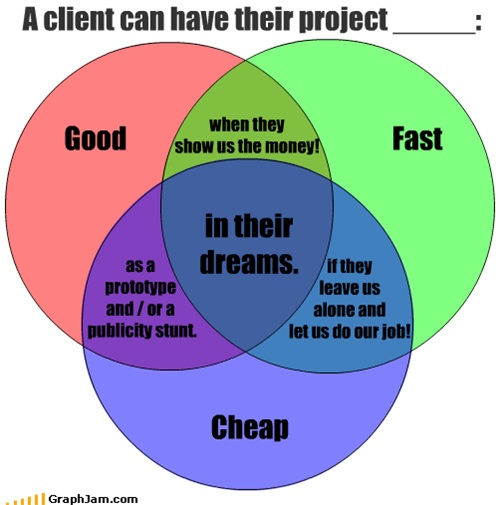 Ron posted a while back about setting freelance rates and provided some guidelines that he used. Well, it caused a bit of a stir, as he quoted some very low numbers. If you read the post, you might do well to red through the comments as well, as an excellent discussion ensued regarding the rates and why Ron used numbers that low.
Ron posted a while back about setting freelance rates and provided some guidelines that he used. Well, it caused a bit of a stir, as he quoted some very low numbers. If you read the post, you might do well to red through the comments as well, as an excellent discussion ensued regarding the rates and why Ron used numbers that low.
Well, Ron’s submitted a follow up. Here it is:
To start things off, I’d just like to clarify a few things.
All this information and advice is a “how” …not a “what” to charge for freelance. No one can determine how much you should charge but you. This (and part 1) are simply the method in which you can take in order to figure out how much to charge for freelance jobs. The actuall number behind your daily rate can only be determined by your own needs and skills/services you offer.
My opinion, charge by the day. Most freelancers have a day job, either very part time or nearly full time. The freelance money helps you to keep busy and have a reasonable total income. By all means this is no reason to underbid yourself, nor is the excuse of being a recent graduate. Since I’m a full time animation instructor now I find less and less spare time to do freelance, but you should always take into account your other responsibilities and how much that “day” means. I have found that charging an hourly rate is unpredictable and it may not suitable for the wide range of projects you may undertake, some are big, some are small. Another way is to charge a ‘project rate’ where you determine a base rate for every project. Like, $5000 for a half-hour episode storyboard, or $24 per sec of animation, or $20 per page for comic book flatting. Base rates that you can set for yourself that stay solid can be a system you find more comfortable with, and can keep things easy and consistent for yourself.
Well each project can be drastically different. You could have a long panning background to paint vs. a bunch of sky cards. You could have a 12 second scene with multiple interacting characters in that scene to animate. That website you’re making motion graphics for… there could be MANY variations of those same graphics to produce that were not anticipated before, the amount of content could be staggeringly large. Either way, sometimes base rates can bite you in the butt.
So a base rate for that website, animation scene, or layout can have a big range of work. To some, a full day is a total of 12 hours. No video games, no YouTube, no Facebook, and no full time job, let’s say you’re between contracts. Factoring eating time, breaks to rest the eyes, and sleep… You are dedicated to putting as much time as you can into freelance, the sooner you get the job done, the sooner you can work on the next project, the sooner you get paid, the more money rolls in.
This could be entirely temporary, since you are going to sign that contract with that animation studio next month. You’re not burned out from your last gig, you need the money, so you pour it on!
Scenarios 1 and 2 don’t really apply here.
You should never underbid yourself, however, depending what your specialty is, you should do some research as to what the going rates are.
Classical feature animator: $300/foot?
3D feature junior animator: $1000/week?
Different studios have different salaries and base wages.
Storyboards, Character Rigging, Modeling, Lighting, Compositing, 2D Character Animation, Special Effects, Hair & Cloth Simulation, Character Design, Assistant Designer or Animator, Color Keys, Location/Environment Design, 3D Set Building, BG Painter/Matte Painter, Layout (2D or 3D), Texturing/Shading… the list goes on and on, with endless variations and junior or senior positions. Each one has a variety of base wages, whether it’s for internet, film or broadcast.
These should only be kept in mind when negotiating. Remember, whether you’re doing freelance for an animation studio or for a single independent client, 95{f2e86ea6af82e2bb048871abf045622abf0ed27fb513932dc1ee8c05a54cbefd} of the time the guy potentially paying you has a pre-determined budget in place. The client (or employer at the company) will balance your asking price with the quality of your work (based upon your online demo/portfolio/work-history). They usually only have a small buffer to work with when considering how much to go over budget, if they find your skills/style is exactly what he/they are looking for, then they’ll be willing to pay a bit more (if they can’t negotiate you down to a lower price).
Never forget, clients and producers are nearly always looking for the lowest bidder, whether they are farming out scenes to individuals or if it’s an independent online client trying to find the right person for this one-time-gig.
 The classic Good-Fast-Cheap Rule has been around for decades. The delicate balance between the three has been sought after ever since television and film production began.
The classic Good-Fast-Cheap Rule has been around for decades. The delicate balance between the three has been sought after ever since television and film production began.
GOOD service CHEAP won’t be FAST
GOOD service FAST won’t be CHEAP
FAST service CHEAP won’t be GOOD
And still there’s conditions for each, because time is always a factor. You can argue that a Good and Fast product won’t be Cheap, but HOW fast? The faster it is, the more people you have to throw at the project, the more people you have on a project the greater the chances that the quality will suffer and the price will rise. On the other hand, the Pixar model shows us that they don’t work fast (taking 5 years versus the usual 3 to make a 3DCG film), they don’t work cheap (Ratatouille cost $150 million to make with a huge army of animation artists on board), and they’re quality is obviously high.
Why doesn’t everyone adopt this method?
Take your time.
Keep the quality high.
Spend a lot of money and resources to get the best talent, technology, and creativity you can find.
Well it can’t always be that way. There’s only so much money and talent to go around, and freelance animation artists have a lot of competition from the majority of clients wanting a product as fast and as cheaply as possible. Only 2{f2e86ea6af82e2bb048871abf045622abf0ed27fb513932dc1ee8c05a54cbefd} of companies/clients/producers out there have the surplus of time and money to burn, and still, look at the countless films produced over the years by incredibly gifted directors/artists that had big budgets to blow, and still they produce big box office flops.
While directing my own studio I learned quickly that filling your animation production with fast-working, talented, and flexible artists was the key. It’s not always easy to do this, but you learn where to look and how to hire over time. This is what people hiring YOU want as well, even though you are in a remote location, they want fast, dependable work. Your positive or negative reputation for being a reliable freelancer will spread quickly. Try to be polite and reasonalbe when negotiating the price of the project, sometimes it feels like you are answering e-mails half the day instead of working, but building a relationship with that new client could mean a lot of work in the future, making connections is EVERYTHING.
Now let’s look at more full-time, long-term freelance situations:
SCENARIO #3
Job: Storyboard a CG-animated 30 sec commercial.
Questions to ask:
-Time frame / Deadline?
-Any designs to use for reference? Interiors/exteriors, props, characters.
-Is this script final?
-Rough thumbnail boards? Clean boards? Color boards?
All these questions ( some lead to more and more, depending on the level of detail ), need some sort of an answer. You might find they don’t understand the questions, the work might come from a live-action-based studio, or a CG design house that don’t do much storyboarding themsleves. The person you’re in contact with might be a production manager or coordinator that might not be familair with the terms you use. In which case, be patient and educate them. If you can find samples of previous works you’ve done that show stages of storyboarding, rough thumbnails and polished final boards, then show them, There’s a big difference in work when a client only wants simple boards that show the framing and composition, and the client that wants detailed poses for every change of expression and position for animators’ reference will take more time to do.
Let’s say you’re set rate is $300 per day. Factoring in revisions, you estimate this to take 3-4 days total with all the back-and-forth talk, revisions, delays and god knows what else, but actual working time comes to 3 to 4 days. Add in a buffer and you got yourself a 5 day price. $1,500 is your asking price to the client. The client is cool with it, so off you go.
Let’s say after some deliberation over the level of detail, and clarifications over design and script stuff, that you determine they need some fairly clean and detailed boards. Not only must it show all the camera mechanics, character poses, framing and composition, but it must have some BG indications and action notes. You clock yourself at doing about 10 pages of clean boards per day (about 30 panels). For the ‘daily-rate’ system to come into play, take a day to breakdown the script and do some rough thumbnails. Pass it off for some notes to the client, if the client isn’t too artistically-inclined you may need a phone conversation, (or lots of writing) in order to describe your rough doodles. Often, I skip handing in thumbnails cause they can’t understand the scribbles, but I do them for myself to build a foundation to work off of. You may be setting yourself up for a lot of unecessary extra work by doing multiple rough passes to show the client, if s/he doesn’t understand (or care) about the preliminary rough pass, you might get lots of notes that you answer a lot of “yes, that will be more clear in the final boards, don’t worry.”
Once you get some revision notes on your first pass, you’re on to the 2nd or 3rd day already, one day or more wasted waiting for some feedback before you continue (this can turn into 2, 3 or 4 days). That’s why having 2 or 3 projects going at at once helps. Once you got the go-ahead to move forward, you figure you can get it all done in 12-15pages. That’s 1.5 days to complete, factor in creating a PDF out of you digital boards, or to scan in, crop and save your paper boards. Triple check all your typed-out or hand-written stage direction notes, package it and send it all out through e-mail or FTP. If you wish to charge them while you’re sitting at home waiting for notes on the boards, that’s up to you. In my experience, the clients usually don’t like that very much, writing out revisions can take time, especially if they show them around to their partners for opinions as well.
Wait for revisions.
Could be 6 hours later, could be 6 days later.
Either way, unless you have no other gigs to work on, you’re stuck waiting.
If the client is unknown to you, this is where you could demand half the money up front.
What? really? Don’t feel comfortable doing that?
That’s fine, it’s a tough thing to do. If it’s a studio you’re doing this for, and you’ve signed something for them, then it could be all good, most likely you’ll see that money, but I’ve heard countless stories from large and small companies, from advertising firms to small television production houses, simply taking the artwork and running with it, or delaying the payment process until they got paid (which could be months later).
Ask for half of the money up front or don’t.
You can always wait till they have their revisions notes, ask them for half the cash before handing in the retakes, then the other half upon deliver of the final hi-res and polished boards. It’s up to you. I always do it for new online clients, when ever the client sounds a bit suspicious when it comes to payment. It can lead to difficult situations, but I’ve been screwed over plenty of times where they promise payment after final delivery, and then weeks go by and they don’t return your calls or e-mails. Just be cautious, once you get burned a few times then you might consider it more seriously, just something to consider.
If they are a reputable company, if you’ve dealt with them before, then chances are, you’re more than safe. You have no idea how many freelancers get swindled ever year, as you’re reading this now, 3 freelancers somewhere in Canada are probably getting screwed over, but don’t even know it.
Protect yourself, when doing animation to an independent client, give them lo-res pencil tests or animation clips, it shows them the work got done and that there’s no reason for YOU to screw THEM over, so you get half the cash up front the other half upon completion of the final hi-res animated piece. It’s a strategy you can use depending on the circumstances. Asking for money up front is usually a bad idea, that seems to be rare in freelance, it’s like asking for an advance on a contract position when you haven’t even proven your worth yet.
When you work in any animation studio environment, you might get paid bi-monthly, 2 weeks of salary for two weeks of work. The payment for your services always comes after. If you demand for half the money upon delivering the first line tests, or first rough board, or the thumbnails of the design or illustrations and you get no responses…then that means you would have completed and delivered your time and skills to someone who would not have paid you anyways. It’s a great way to filter out the clients that had no intention of paying to begin with, as disappointing as that may seem, it’s risk that comes with being a freelancer.
The important thing is, find your ‘daily rate’ and stick with it.
If they want detailed and colored storyboards, you still charge the same $200/day (or whatever you want to charge), and ad on more days according to the length and difficulty of the project.
If all they want is a 30 sec. commercial, quick and dirty stick men, then you charge for a day’s worth of work. Make it clear from the beginning how much revisions you’ll allow (if you feel comfortable with such demands). Re-doing a storyboard 5 times equals to several days of mind-numbing work, that you may not have factored in. Like I said before; factor in a 20{f2e86ea6af82e2bb048871abf045622abf0ed27fb513932dc1ee8c05a54cbefd} buffer. 5 days = 4 work days + 1 day (20{f2e86ea6af82e2bb048871abf045622abf0ed27fb513932dc1ee8c05a54cbefd}) of time allocated towards the unexpected or to do client revisions.
A Storyboard for a 22 minute animated series can take 3 weeks, plus another week of revisions, retakes, and your buffer all added in. Until you do it a few times you’ll never know what your own speed is or how intense the client/producers’ revisions may be. More hours in the day, or a faster work pace may be in order to keep up with deadlines. In which case, increasing your rates or learning more efficient ways of doing your service work may be in order.
SCENARIO #3
Job: Motion Graphics for a Flash website
Questions to ask:
-How many assets?
-Do I create all the art/graphics?
-Is there digital art and design and typography
all ready planned and designed for me to use?
-What is the time frame?
-Layout for the website? Architecture I need to follow? Color scheme?
Visual theme? Infrastructure for how and the content is being displayed.
You estimate that you have three-dozen flying logos and animated text elements to create and make appear and disappear according to their rough layout and flowcharts.
You decide to charge $250 per day. You figure you can create the 36 separate moving graphic elements in just 6 days with all the materials they’ve sent you. That’s an even $1500 dollars. You’ve factored in extra time, you never know what could happen, the EPS files they send you don’t convert to Flash properly, you have trouble re-creating some of the Photoshop graphics they have sent to a vector format, whatever the case, the motion graphics themselves are simple and the interactive programming is done by someone else, you just have to provide all the animation elements. That’s seven little animations per day with time to spare for any revisions and adjustments.
Building a relationship with your clients is the best thing you can do, that’s what makes them come back to you. First and foremost they are seeking someone reliable, someone that understands how fast and at what quality level their product must be produced. I’d say 75{f2e86ea6af82e2bb048871abf045622abf0ed27fb513932dc1ee8c05a54cbefd} of my freelance work came from regular and reoccurring clients and producers. Sometimes the price I offer is too high, they go else where, they appreciated the honesty in the schedule and budget I give them, and 3 weeks later their back with another project, knowing my price range, and the new gig comes through for me. They start to understand your style and your level of work and dedication, you begin to understand their flexibility (or lack of) and their turn-around time and how demanding they can (or can’t) be.
Listen to this amazing speech:
Michael Bierut talks about the Desinger/Client Relationship
You can easily replace ‘designer’ with ‘animator’, lots of common sense, but still inspirational for those long-term freelance animation artists.
I hope you found this all helpful. Again, I can’t stress enough; find the system that works best for you, even if you are just out of college or a 10 year veteran, don’t sell yourself short when starting out in freelance work, no one can decide how much your rates should be but you, and factor in how many hours per day you CAN dedicate to the specific project. Charge too high and the work may get scarce. Charge too low, and you may be in for lots of work as clients take advantage of you. Most of the time production managers and independent clients are looking for the lowest bidder, and the most difficult balance between the trio of Time, Quality and Price is one you may struggle with for a while whether you do the freelance work as a part time moonlighting thing or as a full blown / full time thing.
Your specialties also require some adjustments to your rates, thus some research is involved on your part. Concept art, BG design, layout artist, 3D modeler, compositing/editing, special effects, texturing, shading, rigging, character animation, Flash animation, etc. The more diverse you are the more opportunities it opens, but mastering more than one thing can take time. Freelance work can help keep the rust off your gears during that down-time between contracts, but don’t burn yourself out with lots of low-paying gigs either.
It can be a rough road, with many clients out there not willing to pay as much as you want. Stay loyal to clients who keep coming back to you, don’t be afraid to cut some small discounts for those independent producers that keep returning to you for your services, just to keep them happy and keep the work flowing to you. You never know when they might get that big contract with their next successful pitch.
Whether it’s $80 per day or $300 per day, the more diverse your skills, the wider range of work you can find, and the more specialized and focused your skills are; the more opportunity you can find to get big, high-paying/high-quality work. Adjust your rates according to your needs, according to your experience, and according to the market out there.
It can be a lot of work to get your foot in the door in the beginning, but the pay-off can be rewarding both professionally and financially.
Here’s some invoices, from fancy ones to simple ones:
Download here.
Grant Moore (a commenter on part 1) shared this nice ‘freelance calculator’ site, to help determine your hourly rate:
http://freelanceswitch.com/rates/
Keep upgrading yourself, learn the new software as soon as it comes out. Make yourself valuable to employers whether it’s full time contract work or part time freelance, making yourself valuable is the MOST important thing in getting any work. Keep that demo reel and portfolio up to date, and research constantly. Sites like imaginism studios, videocopilot, idrawgirls, 3Dtutorials, gnomon, jason ryancgtalk have countless tutorials and references that enhance your skills and allow you to be more valuable to those who want to pay you for your skills. Get inspired from the hundreds of sites out there that offer so much insight on the process of art, design and animation; concept art, storyboard art, animation backgrounds, CG design, artistic anatomy and the always-opinionated John K. just to name a few.
and
Good luck!
Ron Doucet
http://floobynooby.blogspot.com






Now that’s some pretty decent advice if you’re starting out, IMO.
Advice columns are tricky. Thanks, Ron!
Between this excellent post and part 1 with discussion, every freelancer should now have every bit of information they need 🙂
Great post, thanks Ron!
Fantastic follow up Ron!!
I especially love the little colour chart!! Hooray for visuals!
Great job Rumble!